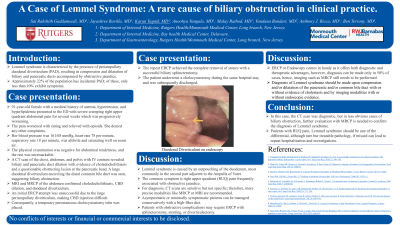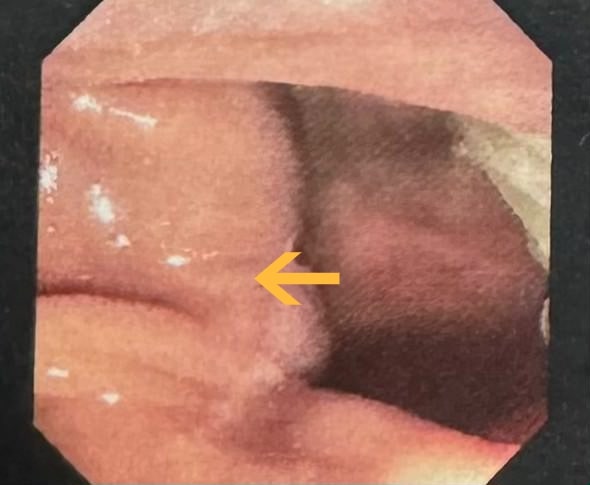Tuesday Poster Session
Category: Biliary/Pancreas
P3618 - A Case of Lemmel's Syndrome: A Rare Cause of Biliary Obstruction in Clinical Practice
Tuesday, October 29, 2024
10:30 AM - 4:00 PM ET
Location: Exhibit Hall E

Has Audio

Karan Yagnik, MD
Monmouth Medical Center, Robert Wood Johnson Medical School of Rutgers University
Long Branch, NJ
Presenting Author(s)
Sai Rakshith Gaddameedi, MD1, Jayasree Ravilla, MD2, Karan Yagnik, MD2, Anoohya Vangala, MD2, Malay Rathod, MD2, Vandana Bandari, MD3, Anthony J. Ricca, MD2, Ben Terrany, MD4
1Monmouth Medical Center, Ocean Township, NJ; 2Monmouth Medical Center, Robert Wood Johnson Medical School of Rutgers University, Long Branch, NJ; 3Bayhealth Medical Center, Dover, DE; 4Monmouth Medical Center, Long Branch, NJ
Introduction: Lemmel syndrome is characterized by the presence of periampullary duodenal diverticulum (PAD), resulting in compression and dilatation of biliary and pancreatic ducts accompanied by obstructive jaundice. Approximately 22% of the population has incidental PAD; of these, only less than 10% exhibit symptoms.
Case Description/Methods: 91-year-old female with a medical history of anemia, hypertension, and hyperlipidemia presented to the ED with severe cramping right upper quadrant abdominal pain for several weeks which was progressively worsening. The pain worsened with eating and relieved with opioids. She denied any other complaints. Her blood pressure was 161/68 mmHg, heart rate 78 per minute, respiratory rate 18 per minute, was afebrile and saturating well on room air. The physical examination was negative for abdominal tenderness, and the rest was unremarkable. A CT scan of the chest, abdomen, and pelvis with IV contrast revealed biliary and pancreatic duct dilation with evidence of choledocholithiasis and a questionable obstructing lesion at the pancreatic head. A large duodenal diverticulum encircling the distal common bile duct was seen, suggesting biliary obstruction. MRI and MRCP of the abdomen confirmed choledocholithiasis, CBD dilation, and duodenal diverticulum. An initial ERCP attempt was unsuccessful due to the large periampullary diverticulum, making CBD injection difficult. Consequently, a temporary percutaneous cholecystostomy tube was placed. The repeat ERCP achieved the complete removal of stones with a successful biliary sphincterotomy. The patient underwent a cholecystectomy during the same hospital stay and was subsequently discharged.
Discussion: Lemmel syndrome is caused by an outpouching of the duodenum, most commonly in the second part adjacent to the Ampulla of Vater. The common symptom is right upper quadrant (RUQ) pain frequently associated with obstructive jaundice. For diagnosis, CT scans are sensitive but not specific; therefore, more precise modalities like MRCP or endoscopy are recommended. Asymptomatic or minimally symptomatic patients can be managed conservatively with a high-fiber diet. Patients with obstructive complications may require ERCP with sphincterotomy, stenting, or diverticulectomy.
In this case, the CT scan was diagnostic, but in less obvious cases of biliary obstruction, further evaluation with MRCP and ERCP is needed to confirm the diagnosis of Lemmel syndrome.

Disclosures:
Sai Rakshith Gaddameedi, MD1, Jayasree Ravilla, MD2, Karan Yagnik, MD2, Anoohya Vangala, MD2, Malay Rathod, MD2, Vandana Bandari, MD3, Anthony J. Ricca, MD2, Ben Terrany, MD4. P3618 - A Case of Lemmel's Syndrome: A Rare Cause of Biliary Obstruction in Clinical Practice, ACG 2024 Annual Scientific Meeting Abstracts. Philadelphia, PA: American College of Gastroenterology.
1Monmouth Medical Center, Ocean Township, NJ; 2Monmouth Medical Center, Robert Wood Johnson Medical School of Rutgers University, Long Branch, NJ; 3Bayhealth Medical Center, Dover, DE; 4Monmouth Medical Center, Long Branch, NJ
Introduction: Lemmel syndrome is characterized by the presence of periampullary duodenal diverticulum (PAD), resulting in compression and dilatation of biliary and pancreatic ducts accompanied by obstructive jaundice. Approximately 22% of the population has incidental PAD; of these, only less than 10% exhibit symptoms.
Case Description/Methods: 91-year-old female with a medical history of anemia, hypertension, and hyperlipidemia presented to the ED with severe cramping right upper quadrant abdominal pain for several weeks which was progressively worsening. The pain worsened with eating and relieved with opioids. She denied any other complaints. Her blood pressure was 161/68 mmHg, heart rate 78 per minute, respiratory rate 18 per minute, was afebrile and saturating well on room air. The physical examination was negative for abdominal tenderness, and the rest was unremarkable. A CT scan of the chest, abdomen, and pelvis with IV contrast revealed biliary and pancreatic duct dilation with evidence of choledocholithiasis and a questionable obstructing lesion at the pancreatic head. A large duodenal diverticulum encircling the distal common bile duct was seen, suggesting biliary obstruction. MRI and MRCP of the abdomen confirmed choledocholithiasis, CBD dilation, and duodenal diverticulum. An initial ERCP attempt was unsuccessful due to the large periampullary diverticulum, making CBD injection difficult. Consequently, a temporary percutaneous cholecystostomy tube was placed. The repeat ERCP achieved the complete removal of stones with a successful biliary sphincterotomy. The patient underwent a cholecystectomy during the same hospital stay and was subsequently discharged.
Discussion: Lemmel syndrome is caused by an outpouching of the duodenum, most commonly in the second part adjacent to the Ampulla of Vater. The common symptom is right upper quadrant (RUQ) pain frequently associated with obstructive jaundice. For diagnosis, CT scans are sensitive but not specific; therefore, more precise modalities like MRCP or endoscopy are recommended. Asymptomatic or minimally symptomatic patients can be managed conservatively with a high-fiber diet. Patients with obstructive complications may require ERCP with sphincterotomy, stenting, or diverticulectomy.
In this case, the CT scan was diagnostic, but in less obvious cases of biliary obstruction, further evaluation with MRCP and ERCP is needed to confirm the diagnosis of Lemmel syndrome.

Figure: Duodenal Diverticulum on endoscopy
Disclosures:
Sai Rakshith Gaddameedi indicated no relevant financial relationships.
Jayasree Ravilla indicated no relevant financial relationships.
Karan Yagnik indicated no relevant financial relationships.
Anoohya Vangala indicated no relevant financial relationships.
Malay Rathod indicated no relevant financial relationships.
Vandana Bandari indicated no relevant financial relationships.
Anthony Ricca indicated no relevant financial relationships.
Ben Terrany indicated no relevant financial relationships.
Sai Rakshith Gaddameedi, MD1, Jayasree Ravilla, MD2, Karan Yagnik, MD2, Anoohya Vangala, MD2, Malay Rathod, MD2, Vandana Bandari, MD3, Anthony J. Ricca, MD2, Ben Terrany, MD4. P3618 - A Case of Lemmel's Syndrome: A Rare Cause of Biliary Obstruction in Clinical Practice, ACG 2024 Annual Scientific Meeting Abstracts. Philadelphia, PA: American College of Gastroenterology.
